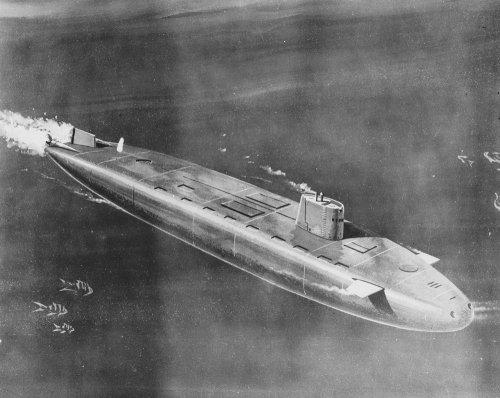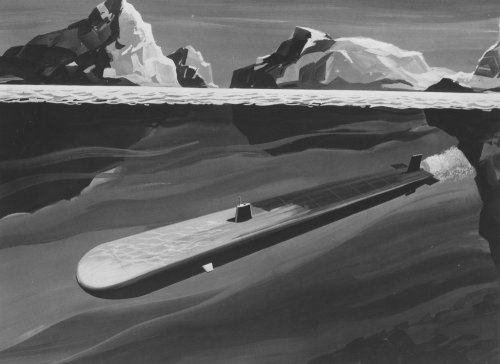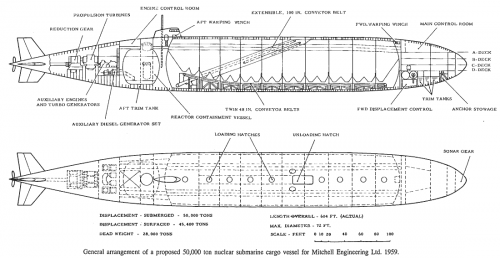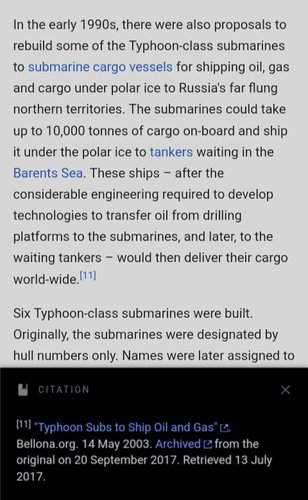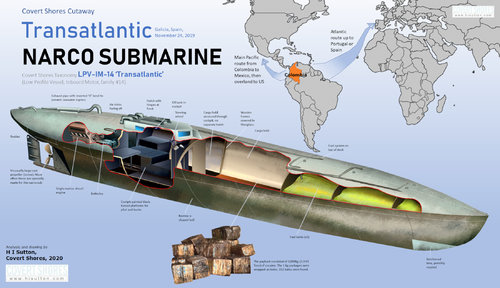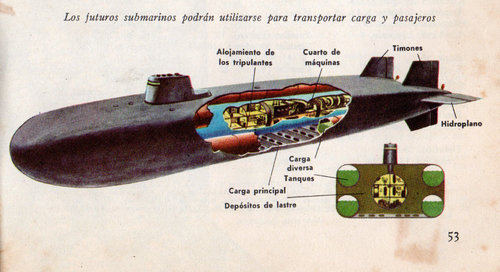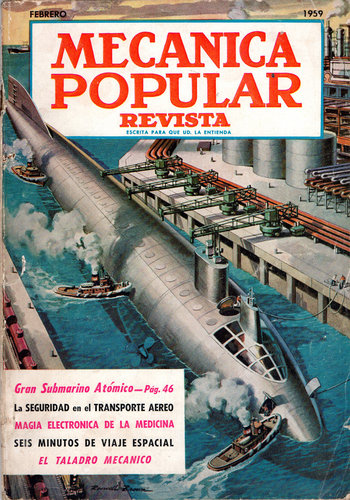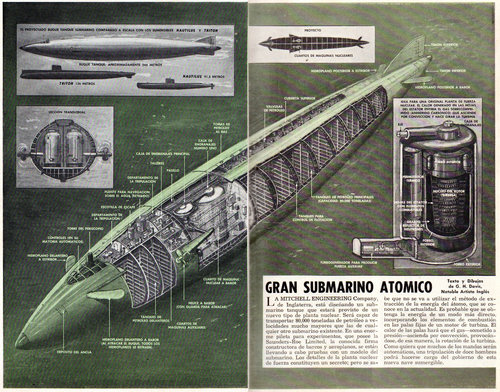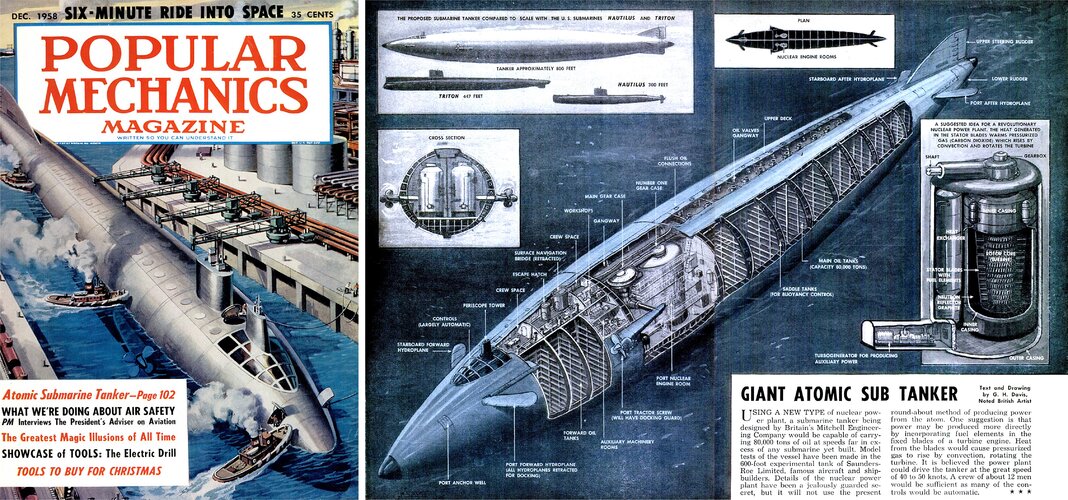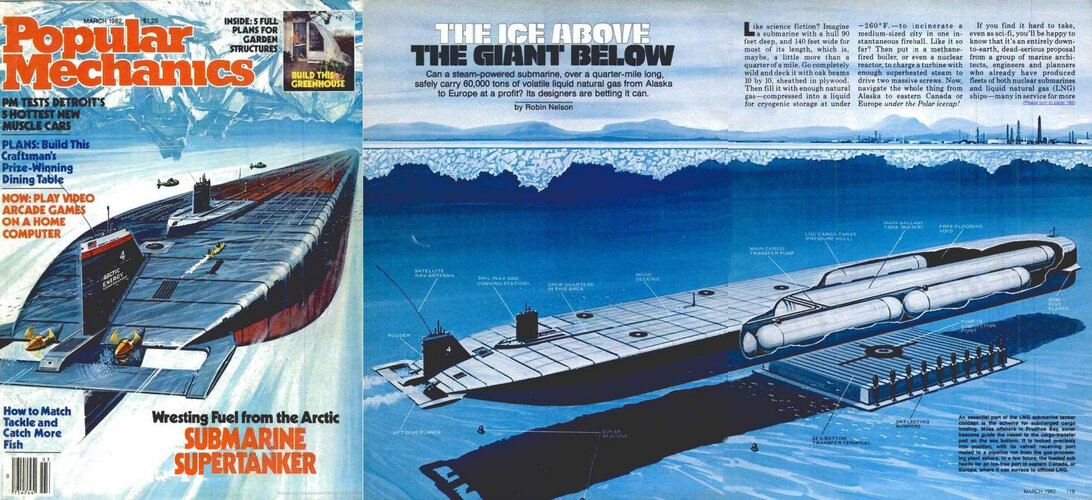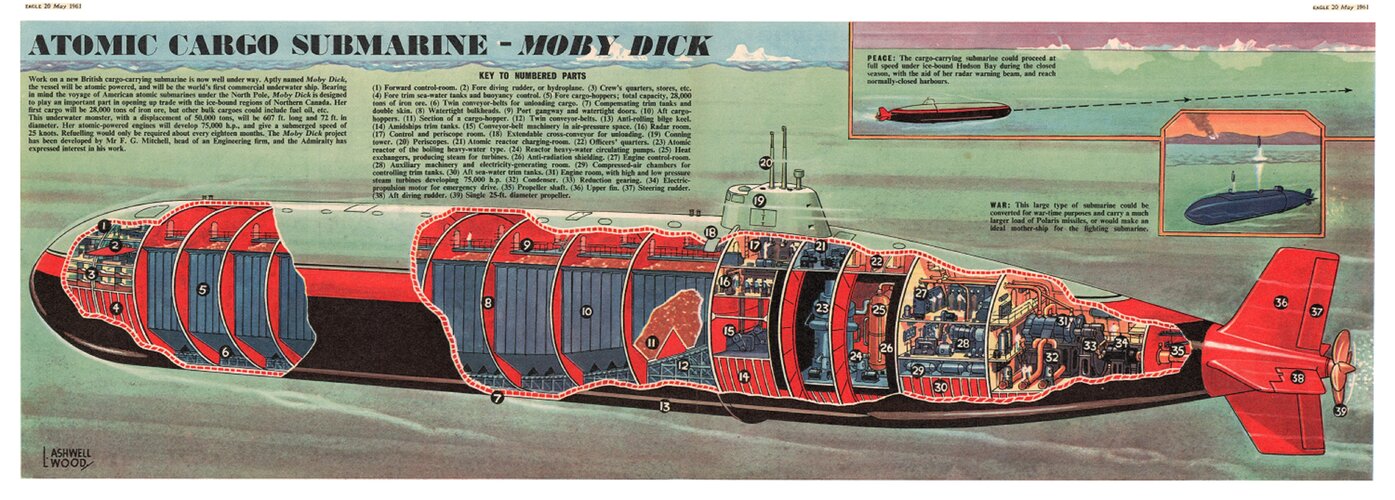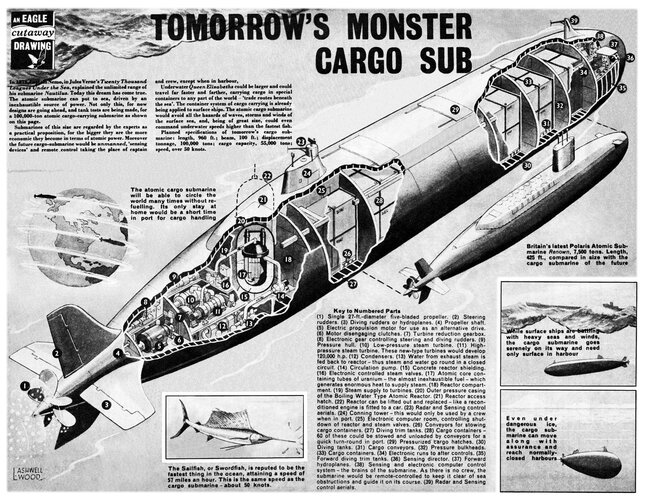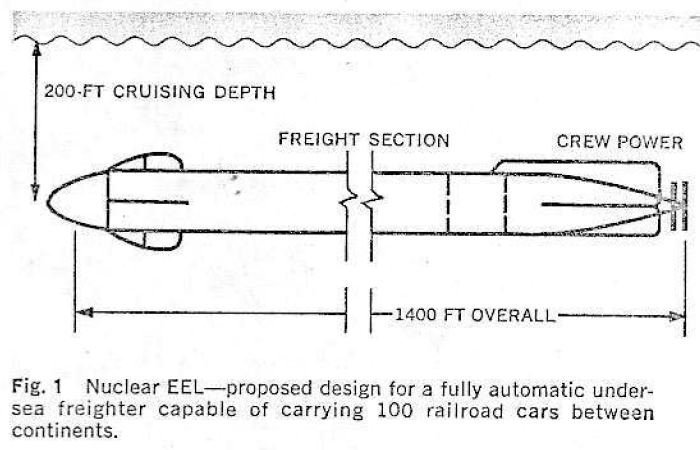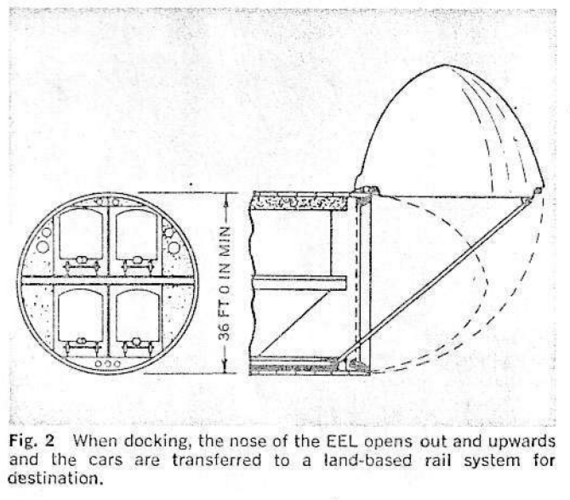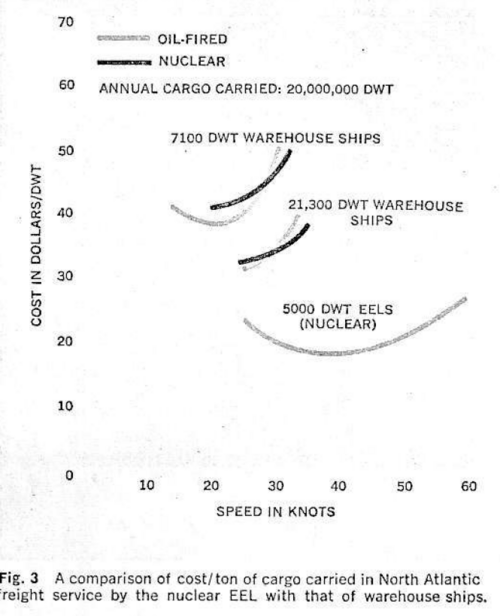You are using an out of date browser. It may not display this or other websites correctly.
You should upgrade or use an alternative browser.
You should upgrade or use an alternative browser.
Commercial (or Semi Commercial) Cargo Submarines
- Thread starter RyanC
- Start date
lastdingo
Blogger http://defense-and-freedom.blogspot.de/
There were actually cargo subs in WWI ... German, of course.
http://en.wikipedia.org/wiki/German_submarine_Deutschland
http://en.wikipedia.org/wiki/German_submarine_Deutschland
Avimimus
ACCESS: Top Secret
- Joined
- 15 December 2007
- Messages
- 2,426
- Reaction score
- 907
And Japanese in WWII (not to mention Russian use of converted subs in the Crimea - which was a concept further developed in the postwar years with dedicated designs).
Is there any conceivable requirement for commercial submarines (other than moving under pack ice)?
Is there any conceivable requirement for commercial submarines (other than moving under pack ice)?
Avimimus said:Is there any conceivable requirement for commercial submarines
Yes. Take one and dress up the deck to look like a conventional surface ship, then sail around near Somalia. Wait for pirates to board, then submerge.
The arguments I've seen are the following;
1. Arctic Oil Tanker - The intention being to move oil under the arctic ice cap to the US eastern seaboard. Unfortunately, the gradual opening of the Northwest Passage due to the northern ice melting reduces the economic incentives.
2. Cargo safety - Traveling underwater is a comparatively steady state operation, with little to no impact from surface storms. If a cargo route goes through areas with significant storms, and there is sufficient depth to escape surface wave effects, this may be viable since the ship travel times would vary very little. The drawbacks being cargo load/unload time, and reduced speed/higher cost when compared to a conventional ship when there are no significant storms. There is a secondary cargo security issue at play as well.
3. Blockade evasion - The WWII german cargo submarines are an example of this. Unfortunately, this really only applies to very high value cargo due to easy detectability of large submarines carrying bulk cargo. The modern equivalent are the current cocaine semisubmersibles (which will probably move to concrete submarine construction at some point in the future, if not conventional steel submarines such as those that have already been discovered)
1. Arctic Oil Tanker - The intention being to move oil under the arctic ice cap to the US eastern seaboard. Unfortunately, the gradual opening of the Northwest Passage due to the northern ice melting reduces the economic incentives.
2. Cargo safety - Traveling underwater is a comparatively steady state operation, with little to no impact from surface storms. If a cargo route goes through areas with significant storms, and there is sufficient depth to escape surface wave effects, this may be viable since the ship travel times would vary very little. The drawbacks being cargo load/unload time, and reduced speed/higher cost when compared to a conventional ship when there are no significant storms. There is a secondary cargo security issue at play as well.
3. Blockade evasion - The WWII german cargo submarines are an example of this. Unfortunately, this really only applies to very high value cargo due to easy detectability of large submarines carrying bulk cargo. The modern equivalent are the current cocaine semisubmersibles (which will probably move to concrete submarine construction at some point in the future, if not conventional steel submarines such as those that have already been discovered)
- Joined
- 11 March 2006
- Messages
- 8,625
- Reaction score
- 3,804
Orionblamblam said:... Wait for pirates to board, then submerge.
Good idea ! This way even the old Type 206 subs, now to be decommissioned, could still serve
in role proposed by our former Federal President: To secure our trade, mimicking, say a sailing
yacht. ;D
But another good task could be, to load crude oil direct at the bore, making oil rigs and long
tubing redundant. Large pollutions had to be achieved another way then !
- Joined
- 11 March 2006
- Messages
- 8,625
- Reaction score
- 3,804
Let
Let's see ! Would be a lot more difficult for Somali pirates to board such a ship ! ;D
And those guys can increase charges for insurance, too. Maybe shipyards, which are
able to produce such ships, should invest in small speedboats, Kalashnikovs and RPG-7s
in the meantime ? B)
skyrider said:How much they are going to charge for insurance for commercial cargo submarine? It will never work.
Let's see ! Would be a lot more difficult for Somali pirates to board such a ship ! ;D
And those guys can increase charges for insurance, too. Maybe shipyards, which are
able to produce such ships, should invest in small speedboats, Kalashnikovs and RPG-7s
in the meantime ? B)
- Joined
- 9 October 2009
- Messages
- 21,973
- Reaction score
- 13,622
Via Shipbucket, the 'Submarine Train'.
- Joined
- 9 October 2009
- Messages
- 21,973
- Reaction score
- 13,622
You could also say that this topic is related: http://www.secretprojects.co.uk/forum/index.php/topic,10902.0.html
Nik
ACCESS: Top Secret
- Joined
- 15 July 2009
- Messages
- 1,269
- Reaction score
- 1,062
http://en.wikipedia.org/wiki/The_Dragon_in_the_Sea
aka 'Under Pressure', Author Frank Herbert
http://en.wikipedia.org/wiki/Dracone_Barge
By curious coincidence, development of Dracone flexible 'barges' began shortly after the book's publication...
aka 'Under Pressure', Author Frank Herbert
http://en.wikipedia.org/wiki/Dracone_Barge
By curious coincidence, development of Dracone flexible 'barges' began shortly after the book's publication...
- Joined
- 9 October 2009
- Messages
- 21,973
- Reaction score
- 13,622
I wouldn't say that this is any great surprise; Via our rivials at Militaryphotos.net:
http://ca.news.yahoo.com/red-october-real-maps-suggest-soviet-subs-cruised-093009696.html
The old Soviet Union may have been just as familiar with Canada's Arctic waters as Canadians.
Sections of Cold-War-era nautical charts obtained by The Canadian Press suggest that Russian mariners have for decades possessed detailed and accurate knowledge of crucial internal waterways such as the Northwest Passage.
Those charts, which may offer the first documentary proof of the widely held belief that Soviet nuclear submarines routinely patrolled the Canadian Arctic during the Cold War, are still in use by Russian vessels. In some places, they are preferred to current Canadian charts.
http://ca.news.yahoo.com/red-october-real-maps-suggest-soviet-subs-cruised-093009696.html
from 'Storia Militare', an italian historical magazine, the project of a pre-WWII submarine oil tanker, with carachteristics.

Uploaded with ImageShack.us

Uploaded with ImageShack.us
and, from the same source, drawings and characteristics of the transport submarines R class, of WWII, of the Italian Navy

Uploaded with ImageShack.us

Uploaded with ImageShack.us

Uploaded with ImageShack.us

Uploaded with ImageShack.us
and, from the same source, drawings and characteristics of the transport submarines R class, of WWII, of the Italian Navy

Uploaded with ImageShack.us

Uploaded with ImageShack.us
- Joined
- 9 October 2009
- Messages
- 21,973
- Reaction score
- 13,622
http://www.institutenorth.org/assets/images/uploads/files/Power.pdf
- Joined
- 9 October 2009
- Messages
- 21,973
- Reaction score
- 13,622
Some interesting material on Axis submarine blockade runners on pages 175-177 (pdf pages 200-202) of this old 1953 USN study: SPECIAL REPORT ON OPERATIONS AND ORGANIZATION OF THE GERMAN NAVAL SUPPLY SYSTEM DURING WORLD WAR II
- Joined
- 5 May 2007
- Messages
- 351
- Reaction score
- 409
George Allegrezza said:While Searching For Something Else (WSFSE?), I came across this 1981 General Dynamics proposal for submersible LNG tankers:
http://www.navalprofessional.com/vessels/submarine-carrier-proposed-dynamics-4482
The boats were intended to be 1470 ft long and could have nuclear or non-nuclear propulsion. The conops was to ship LNG from Alaskan waters to consumers in Europe and Japan.
Although the sail on the boat in the photo is toward the bow rather than the stern (as for the artist rendering of the GD LNG carrier in the item at Naval Professional), this appears to be related.
Posted at the San Diego Air & Space Museum (SDASM) Flickr photostream:
http://www.flickr.com/photos/sdasmarchives/8126225660/in/photostream
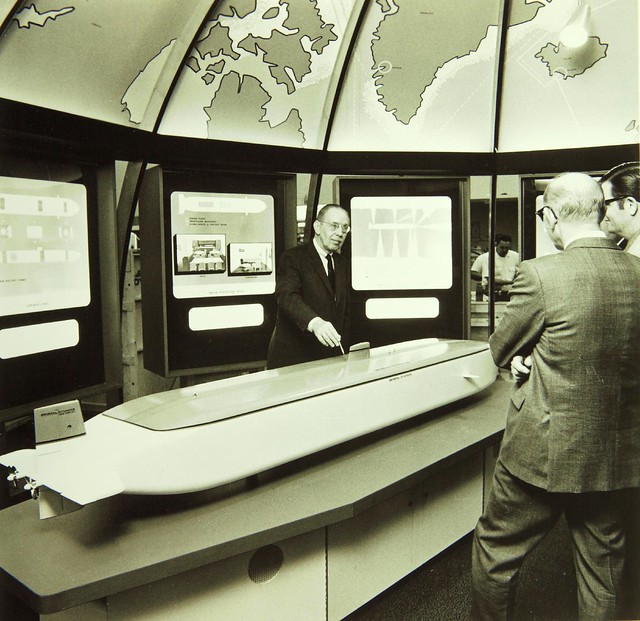
- Joined
- 9 October 2009
- Messages
- 21,973
- Reaction score
- 13,622
http://www.shipbucket.com/forums/viewtopic.php?f=13&t=4417
These post-war designs may be related in some way: http://www.secretprojects.co.uk/forum/index.php/topic,1857.0.html
These post-war designs may be related in some way: http://www.secretprojects.co.uk/forum/index.php/topic,1857.0.html
J
joncarrfarrelly
Guest
- Joined
- 5 May 2007
- Messages
- 1,483
- Reaction score
- 2,859
Very interesting - whilst obviously intended for dry bulk cargoes, it would be fairly straightforward to produce a similar design for bulk oil. I'd be surprised if Saunders-Roe hadn't drawn one up, actually.
- Joined
- 9 October 2009
- Messages
- 21,973
- Reaction score
- 13,622
- Joined
- 9 October 2009
- Messages
- 21,973
- Reaction score
- 13,622
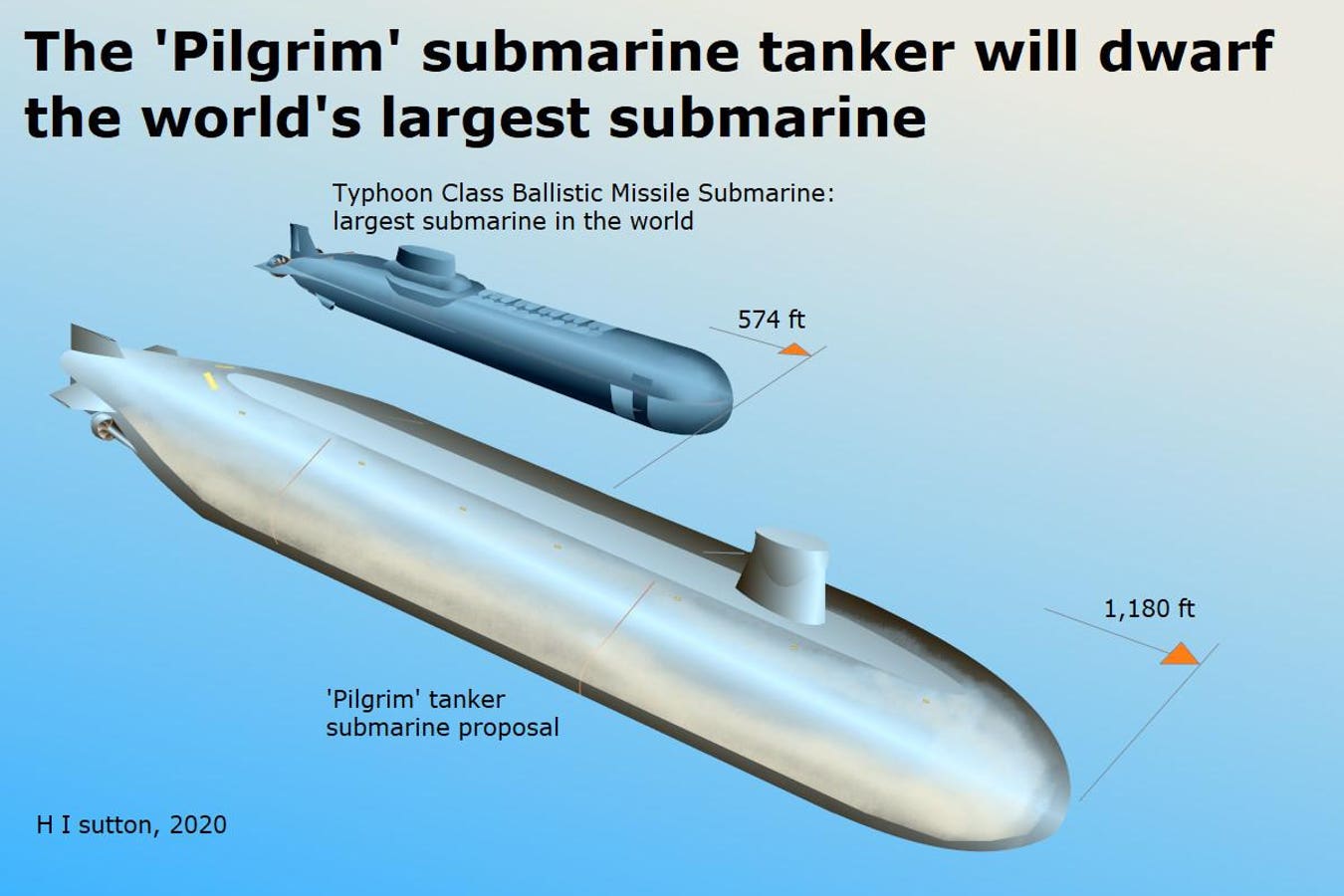
The Largest Submarine In The World Could Get Eclipsed
Russian engineers have proposed a massive submarine tanker capable of carrying 170,000-180,000 tons at a time. This would dwarf the mighty Typhoon Class ballistic missile sub, which is the largest submarine ever built.
 www.forbes.com
www.forbes.com
Julio Garay Terrazas
ACCESS: Confidential
- Joined
- 23 March 2020
- Messages
- 115
- Reaction score
- 257
¿Is valid these kind of submarines? https://en.wikipedia.org/wiki/Narco-submarine
https://funnyjunk.com/Evolution+of+nacro+subs/lnmeMya/
https://funnyjunk.com/Evolution+of+nacro+subs/lnmeMya/
Attachments
Julio Garay Terrazas
ACCESS: Confidential
- Joined
- 23 March 2020
- Messages
- 115
- Reaction score
- 257
I found this image in this old kid book from 1969: https://www.iberlibro.com/SUBMARINOS-sd-Novaro-Mexico/5206418080/bd
Is the only image about submarines from the future. Text is almost nothing.
PD: I get the book in 1983.
Is the only image about submarines from the future. Text is almost nothing.
PD: I get the book in 1983.
Attachments
Julio Garay Terrazas
ACCESS: Confidential
- Joined
- 23 March 2020
- Messages
- 115
- Reaction score
- 257
- Joined
- 9 October 2009
- Messages
- 21,973
- Reaction score
- 13,622
Roodbaard1958!
ACCESS: Confidential
- Joined
- 26 December 2019
- Messages
- 97
- Reaction score
- 130
Hi, do you still possessed that Italian historical magazine, I am interested in the submarine oil tankerfrom 'Storia Militare', an italian historical magazine, the project of a pre-WWII submarine oil tanker, with carachteristics.

Uploaded with ImageShack.us

Uploaded with ImageShack.us
and, from the same source, drawings and characteristics of the transport submarines R class, of WWII, of the Italian Navy

Uploaded with ImageShack.us

Uploaded with ImageShack.us
And now for something slightly bonkers: The "Nuclear EEL", a 1969 proposal for a 1400*38ft, 40-50 knot shallow diving (200ft) nuclear powered train ferry for trans-oceanic cargo routes. Extensive use of concrete for permanent ballast, and un/loading performed by hauling the thing part way up a ramp and opening the nose. Being right before containerisation took off, the author focuses on the ease of cargo handling in rail ferries compared to the general cargo ships then in use.
Reference: Whitelaw, RL, "The Nuclear EEL", Mechanical Engineering Nov. 1969.
RP1's comment: Given how much time was spent in handling cargo, pretty much any kind of modularisation; container, rail, barge, was much cheaper. In engineering terms however this thing is bonkers. The L/D ratio is so far off the charts I could only guess what the power required would be. Depth control at speed would be a nightmare - a five degree angle means the bow and stern are 120ft different in depth.
Reference: Whitelaw, RL, "The Nuclear EEL", Mechanical Engineering Nov. 1969.
RP1's comment: Given how much time was spent in handling cargo, pretty much any kind of modularisation; container, rail, barge, was much cheaper. In engineering terms however this thing is bonkers. The L/D ratio is so far off the charts I could only guess what the power required would be. Depth control at speed would be a nightmare - a five degree angle means the bow and stern are 120ft different in depth.
Attachments
- Joined
- 9 October 2009
- Messages
- 21,973
- Reaction score
- 13,622
First Trans-Atlantic Narco Submarine found in Africa H I Sutton - Covert Shores
Has anyone proposed construction work via submersibles?
The Drake Passage is incredibly violent, yet I could see that as a source of wind and sea power.
Too violent for surface ships—but, just perhaps—one could tow telescoping well under the surface then have the structure break the surface as a Jack-Up Rig in reverse.
Keep filling in the gaps and you can get a bridge.
Maintenance done below the surface.
The Drake Passage is incredibly violent, yet I could see that as a source of wind and sea power.
Too violent for surface ships—but, just perhaps—one could tow telescoping well under the surface then have the structure break the surface as a Jack-Up Rig in reverse.
Keep filling in the gaps and you can get a bridge.
Maintenance done below the surface.
Scott Kenny
ACCESS: USAP
- Joined
- 15 May 2023
- Messages
- 11,628
- Reaction score
- 14,324
Aw, hell no.And now for something slightly bonkers: The "Nuclear EEL", a 1969 proposal for a 1400*38ft, 40-50 knot shallow diving (200ft) nuclear powered train ferry for trans-oceanic cargo routes. Extensive use of concrete for permanent ballast, and un/loading performed by hauling the thing part way up a ramp and opening the nose. Being right before containerisation took off, the author focuses on the ease of cargo handling in rail ferries compared to the general cargo ships then in use.
Reference: Whitelaw, RL, "The Nuclear EEL", Mechanical Engineering Nov. 1969.
RP1's comment: Given how much time was spent in handling cargo, pretty much any kind of modularisation; container, rail, barge, was much cheaper. In engineering terms however this thing is bonkers. The L/D ratio is so far off the charts I could only guess what the power required would be. Depth control at speed would be a nightmare - a five degree angle means the bow and stern are 120ft different in depth.
Do NOT want to drive that monster. No way, no how. Your cargo is going to do "trim parties" on you, 200ft is not deep enough to get you clear of heavyweight haulers or surface effects from big storms, and you're absolutely not safely doing 40-50 knots at 200ft.
What's a trim party? That's when you get 150 people running from one end of the ship to another as quietly as they can to mess with a newly-qualified dive or chief of the watch. If those railcars are not locked down SOLIDLY, they're going to shift back and forth and completely mess up the ship's trim.
I had a really bad PD trip once. Taking rolls at 200ft, got sucked up to the surface from 160ft. And that's depth to keel, so the top of the hull was more like 110ft from the surface. Fought us down, sank out to 200ft. Tried again, sucked back up to the surface. Spent the next 45 min broached bigger than hell, waves so tall that the guy on the periscope couldn't see the tops of the big waves with the headpiece cranked all the way up. 27deg rolls side to side, +-10 in pitch, and heaving probably +-10ft. Finally caught a good wave across the fairwaters and was able to get down to 200ft.
Had another time when the Captain was trying to run on the treadmill, and we were rolling enough to be annoying at 300ft. "Off'sa'deck, from the Captain, make your depth 400 feet."
And finally, at 200ft you're going to be lucky to be safely doing 15 knots. You want to do 40-50 knots, you need to be closer to 600-800ft down. That's not a matter of noise, it's a matter of being able to not exceed your crush depth if/when the stern planes decide to blow their packing out and jam at "full dive" position.
Not to mention that trying to offload train cars while the sub/tracks are at a ~2deg incline is going to be miserable. You'd be better off sticking the sub into a drydock and pulling the trains out flat!
You'd need something comparable to NR-1 to be able to do that well. Maybe not a nuclear boat, what with modern battery/AIP abilities, but you'd need something that could spend a month or more underwater.Has anyone proposed construction work via submersibles?
The Drake Passage is incredibly violent, yet I could see that as a source of wind and sea power.
Too violent for surface ships—but, just perhaps—one could tow telescoping well under the surface then have the structure break the surface as a Jack-Up Rig in reverse.
Keep filling in the gaps and you can get a bridge.
Maintenance done below the surface.
Plus you'd need to be doing all the work at probably 400ft down. Maybe deeper. Kentucky went around that way (maybe not Drake Passage), and was taking rolls when they were DEEP. So we'd be talking saturation diver support, and/or ROVs.
Scott Kenny
ACCESS: USAP
- Joined
- 15 May 2023
- Messages
- 11,628
- Reaction score
- 14,324
Not sure how much telepresence can do if we're needing welding done, but yes otherwise I believe that's viable. Particularly for inspection.That and telepresence.
southwestforests
ACCESS: Top Secret
- Joined
- 28 June 2012
- Messages
- 757
- Reaction score
- 1,219
Oh, oh! I just figured out how to get rich quick selling cargo submarines ... I'm going to build and sell roll-on, roll-off, automobile carrier submarines specifically for transporting EVs having lithium ion batteries!

- Joined
- 5 May 2007
- Messages
- 1,483
- Reaction score
- 2,859
In fairness, that's a problem on normal train ferries too. Though they do have the small advantage that when the cargo decides to unload itself of its own volition, it doesn't take the whole ship with it. Usually.If those railcars are not locked down SOLIDLY, they're going to shift back and forth and completely mess up the ship's trim.
There was a lot of interest in crewed submersibles for subsea work in the 1960s and 1970s, including the rather unfortunate experience of Pisces III. ROVs ate the lunch of the 1-atmosphere submersibles.You'd need something comparable to NR-1 to be able to do that well. Maybe not a nuclear boat, what with modern battery/AIP abilities, but you'd need something that could spend a month or more underwater.
For dive support, saturation divers very quicky said not just no, but hell no to not being connected to the surface. There were a few submersibles built for it (not just the Johnson Sea-Link) but they were seriously unpopular.
There are a lot of parallels between spaceflight and subsea work, not just in timeframe but also in the way that developments in uncrewed systems made crewed ones largely obsolete.
A joke, I know—but a hold full of EVs might well power that sub.Oh, oh! I just figured out how to get rich quick selling cargo submarines ... I'm going to build and sell roll-on, roll-off, automobile carrier submarines specifically for transporting EVs having lithium ion batteries!

Some pirate tries to steal it empty—they’re in for a (no) shock.
Similar threads
-
-
-
Nuclear Research Submarine (U.S. Department of the Interior, early 1970s)
- Started by Grey Havoc
- Replies: 0
-
British Ships Taken Up from Trade (STUFT) other than Falklands
- Started by uk 75
- Replies: 2
-

